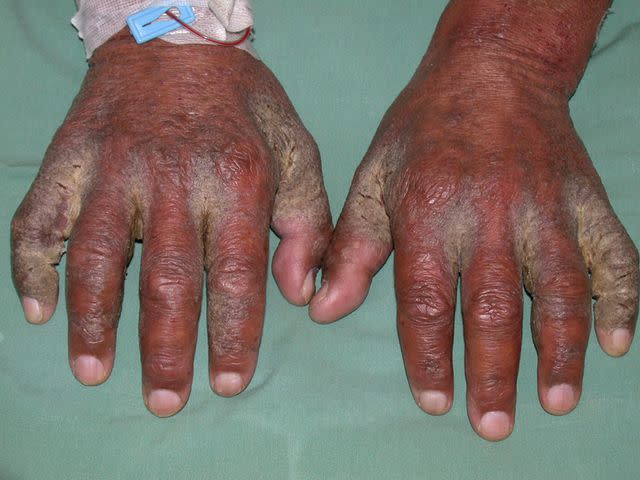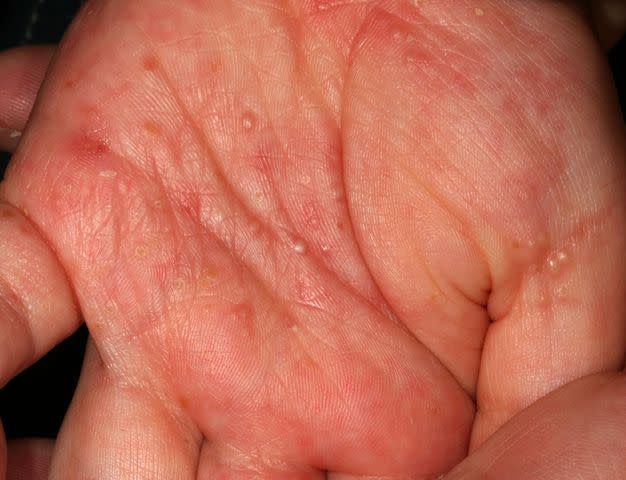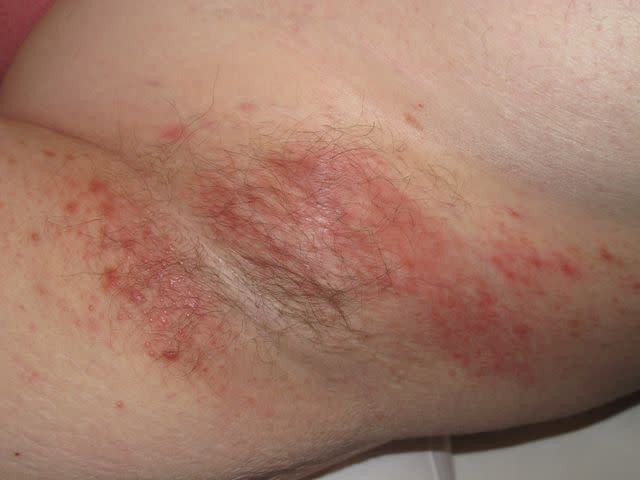Scabies Pictures: What It Looks Like
Medically reviewed by William Truswell, MD
Scabies commonly presents as a red rash with small bumps that often form a line. Other symptoms of scabies include itching, blistering, and scaling.
According to the World Health Organization (WHO), scabies affects over 200 million people in the world at any one time. The condition is more common in young children and older adults, especially in poor communities that lack healthcare resources.
In this article, you'll find pictures of scabies rashes to help you identify it. It will also cover the symptoms and causes of scabies and how to prevent and treat it.

Reproduced with permission from © DermNet New Zealand www.dermnetnz.org 2023.
What Does Scabies Look Like?
A scabies rash can look slightly different from person to person but has some common features.

Raimo Suhonen / DermNet / CC BY-NC-ND
Scabies rash on handItch
Most people will experience itching that can be severe and make it tough to sleep at night. Itching may be so bad scratching breaks the skin and makes the skin appear redder and more inflamed.
Burrows
Scabies mites are tiny parasites. You can’t see mites without a microscope, but you can spot the burrows they create under the skin's surface. These minute tunnels may appear like lines on the surface of your skin. They sometimes have a grayish tint or vary in color from your natural skin tone.
Generalized Rash

DermNet / CC BY-NC-ND
While scabies burrow under the skin, they also irritate it, causing a red rash that can mimic other types of skin irritation. In some people, particularly young children, a scabies rash may involve pus-filled bumps.
Scabies Rash Location
Scabies mites prefer certain locations on the human body, especially skin folds and anywhere covered by clothing or jewelry. Other common spots for scabies rashes include:
Genitals
Buttocks
Waistline
Hands and arms
Nipple area
However, you can develop a scabies rash in other areas. You can also have scabies in multiple areas.
Other Symptoms
How do you know it’s scabies? While a rash with burrows is pretty distinct and usually clinches a diagnosis, other signs of a scabies mite infestation include:
Severe itching at night
Crusted skin
Crusted skin can happen if you scratch, break open the skin, and a scab forms. Crusting is also a sign of crusted scabies, a severe form of scabies infestation that involves millions instead of a handful of mites. People with crusted scabies may also have open sores.
Related: Symptoms of Scabies
Causes
The human itch mite causes scabies rash. You can get scabies via skin-to-skin contact with someone who has scabies. While less common, you can also contract scabies from sharing towels, clothing, or bedding with someone who has scabies. You cannot get scabies from pets.
Crusted scabies occurs in people with a weakened immune system. This can allow the mites to proliferate without control. You’re at higher risk for crusted scabies if you:
Are an older adult
Take immunosuppressants (drugs that block part of the immune system) for conditions such as organ transplant or autoimmune conditions (in which the immune system mistakenly attacks the body)
Are immunocompromised (have a weakened immune system) due to conditions such as HIV/AIDS, lymphoma (cancer of the lymphatic system), or leukemia (blood cancer)
Is Scabies Contagious?
Yes. This skin condition is highly contagious but requires skin-to-skin contact. The crusted form of scabies is even more contagious. This is because scabies mites can live for several days apart from the human body, and those attached to crusted and shredded pieces of skin may live even longer.
Diagnosing Scabies
A healthcare provider can diagnose scabies by visually examining your skin for lines or burrows. The diagnosis of scabies can be confirmed by identifying the mite, mite eggs, or mite fecal matter under a microscope.
When To See a Healthcare Provider
There's no at-home test for scabies. If you think you have scabies or some other itchy skin condition, see a healthcare provider right away. If it is scabies, you’ll need a prescription treatment.
Related: How Scabies Is Diagnosed
What Can Be Mistaken for Scabies?
Scabies can resemble itchy rashes caused by other conditions, such as:
Treatment
You need a prescription scabicide to treat scabies rash. These are prescription lotions or creams that are applied to the skin. You can’t treat it with at-home or over-the-counter (OTC) remedies.
Some people need multiple rounds of treatment to kill the mites and their eggs, especially those with crusted scabies. Your healthcare provider may also prescribe medications to help with symptoms like itching or infection due to constant scratching.
In addition to receiving medical treatment, you will also need to take steps to rid your clothing, linens, upholstery, and carpets of the mites to prevent re-infestation.
Related: How Scabies Is Treated
Prevention
Treating scabies rash is an important part of preventing the spread of these mites. If you don’t have a rash, you can’t transmit it to someone else.
If you or someone else in your household has a scabies infestation, the American Academy of Dermatology (AAD) also recommends the following:
Wash clothing and other textiles like sheets, pillowcases, and towels in the hottest water possible and dry on the hottest setting.
Vacuum your home, especially common living spaces.
Seal non-washable items in a plastic bag for at least a week.
Related: How to Prevent Scabies
Summary
A scabies mite infestation causes a red rash and burrow-like lines on the skin. It can also cause severe itching. Often, the rash crops up in skin folds or places commonly covered by clothing or jewelry, like the hands. You need a prescription to treat this skin condition and can’t treat it with home remedies. If you suspect you have scabies, contact a healthcare provider so you can get effective treatment to kill the mites and prevent transmitting them to others.
Read the original article on Verywell Health.

